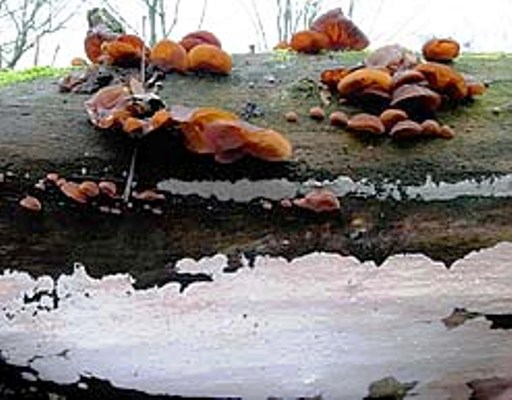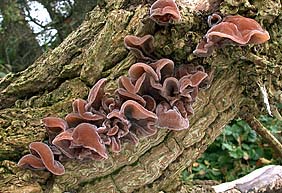Nutrition
Everyone and everything needs food to survive. It is not possible to survive long without the proper nutrients and resources. The Auricularia auricula-judae fungi are known as saprophytes. Saprophytes are organisms that grow on dead organic material and in this case, trees. I did explain a little bit on how they go about "eating" this organic material, but let me elaborate. As mentioned earlier, this fungus is heterotrophic so it has to obtain its food elsewhere and cannot produce it on its own like plants can. It accomplishes that through absorption. I also explained earlier how these fungi excrete a powerful enzyme that is able to perfectly eat away the dead wood of trees by breaking down the polymer lignin. Once it is broken down, the fungus then absorbs all the smaller particles to be satisfied.
©Jen H. Petersen/mycokey.com
 Fungi are well known to have a morphology that allows them to intake as
many nutrients as needed. First of all, we have the hyphae which I explained
as tiny filaments that have cell walls consisting of chitin. Chitin is a
polysaccharide that gives the cell wall its strength yet flexibility
(Campbell, 2008.) From there, we have more than one hyphae forming together
into a mycelium which is the part of the fungus that penetrates the food
source. This structure is known to grow at a fast rate and is also
proficient as absorbing nutrients. All of which is used up into making more
hyphae to increase the area that they have for absorption. The
Basidiomycetes tend to stay at the stage in their life mostly as dikaryotic
mycelium and mostly produce fruiting bodies (the mushroom-like structure)
when conditions for growth and reproduction are favorable.
Fungi are well known to have a morphology that allows them to intake as
many nutrients as needed. First of all, we have the hyphae which I explained
as tiny filaments that have cell walls consisting of chitin. Chitin is a
polysaccharide that gives the cell wall its strength yet flexibility
(Campbell, 2008.) From there, we have more than one hyphae forming together
into a mycelium which is the part of the fungus that penetrates the food
source. This structure is known to grow at a fast rate and is also
proficient as absorbing nutrients. All of which is used up into making more
hyphae to increase the area that they have for absorption. The
Basidiomycetes tend to stay at the stage in their life mostly as dikaryotic
mycelium and mostly produce fruiting bodies (the mushroom-like structure)
when conditions for growth and reproduction are favorable.
©Jen H. Petersen/mycokey.com
To continue, this jelly ear fungus is known to be a saprobe to many trees which are later expressed under the relationships section of this web page. Other saprophytes act like this fungus include the Oyster mushroom (Pleurotus ostreatus) and the Pear-Shape Puffball (Lycopedon pyriforme) which are also edible. However, it does have some parasites such as the Bensingtonia ciliata which will also be explained in the relationships section.
So now you know what it does to obtain its nutrients and be able to undergo its interesting changes depending on dryness. Now, let's discover how this fungus reproduces more of these little "guys".
Go back to the Home page.
